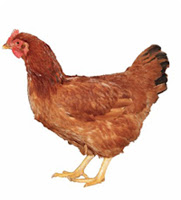Prolapse In Poultry: Causes And Treatment
Prolapse vent in chickens is a condition in which the lower part of a hen’s oviduct turns inside out and protrudes through the vent. It is totally normal for the vent to temporarily prolapse when laying but definitely not normal for it to remain that way. It is a disease that majorly affect layers but that does not mean it cannot affect broilers, turkey or any other birds. Prolapsed vent is a serious condition that can be treated if detected early but likely to recur. It is also known as prolapsed oviduct or cloacal prolapse.
Causes
There are various factors that can contribute to prolapsed vent but soon of the major causes are:
1.) Diet – a lack of calcium and magnesium has been linked to vent prolapse.
2.) Weight – both being underweight or over weight can contribute to a vent prolapse.
3.) Age – a very young hen trying to pass a very large egg can lead to a vent prolapse. Older chickens that are obese and have lost muscle tone are also prone to vent prolapse.
4.) Infection – often times a vent prolapse can be the result of an undetected abdominal or oviduct infection.
5.) Egg Size – Consistent oversized or misshapen eggs can weaken and damage muscle tissue leading to a vent prolapse.
6.) Holding droppings for a long period of time, causing stress and stretching of the cloaca.
Note: Not all the causes are preventable. Some farmers believe there is a genetic component as well. That makes it important to recognize (diagnose) prolapse at early stage and treat as soon as possible.
Diagnosis
1. Just try to know your flock well by close monitoring because if the hen is not showing an extensive amount of exposed tissue, sometimes it can be hard to catch a vent prolapse when it’s starting.
2. If you gently turn any suspected hen upside down, a quick visual inspection on her vent area will show you if there is any external tissue exposed. If you see exposed tissue, treat accordingly.
3. Look for any signs of distress with the hen, lack of appetite, lethargy, fluffing out feathers, lack of egg production, bloody eggs or being bullied by the other members of the flock.
The biggest danger to a chicken with prolapse is other chickens pecking the reddened area which can cause hemorrhage, the chicken’s oviduct and/or intestines being pulled out and eventual death from cannibalism.
Treatment
* Separate the affected bird from your flock.
* Clean protruding tissue well preparing a nice warm bath for your hen. Add some iodine to help disinfect the area.
* Wear gloves, lubricate your fingers with a water based lubricant and replace the tissue manually by pushing it back into place.
* Treat the swollen tissue to help shrink it down so as to stay in place. Honey could be used but make sure to treat the affected tissue both internally and externally so your hen can recover fully.
* Provide vitamins and electrolytes or liquid calcium to restore the ability of the uterus muscle to contract properly.
* Consider antibiotics if tissue is compromised by pecking or is especially dirty.
* Monitor vigilantly for the lifetime of the chicken.
With all we have been able to discuss, I want to believe the main problems about prolapsed vent in poultry is being solved. If all these cannot work for you, then you need to consult us and let us do it in togetherness.
For quick updates and comments, follow us on our social media connects; FacebookPage, TwitterHandle and Instagram. You can also subscribe and watch videos on our YouTube channel. At Artib Farm, we materialize your satisfaction!
References
1 Damerow, Gail (1994). The Chicken Health Handbook. page 53: Storey Publishing.
2. https://artibfarm.blogspot.com/2018/06/electrolytes-for-chickens.html
3. https://thefrugalchicken.com/vent-prolapse-how-to-recognize-treat-your-hen/
4. Photo credit to armorfirelady and backyardpoultry.com




Comments
Post a Comment